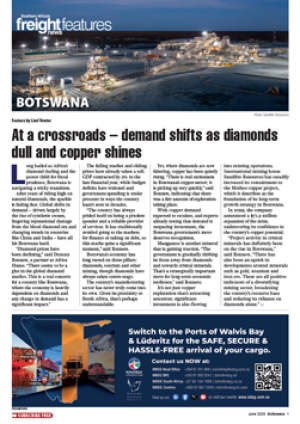Strategic focus on dramatic
turnaround strategy
Ray Smuts
SOUTH AFRICAN Port Operations' "most pressing" operational imperative is to increase capacity and improve ship turnaround time in all ports, says SAPO's newly-appointed chairman Dr Bongani Khumalo.
The former c.e.o of Eskom and head of the government Aids Commission, Dr Khumalo told his dinner audience in Cape Town last week that SAPO was key to supporting the success of government's export-led growth strategy.
"Under the leadership of Tau Morwe, SAPO has focused its strategic direction on a dramatic turnaround strategy and examined the competitive global market to set sights as high as the most forward thinking of the international ports (Hamburg and Singapore) as they lead the international standard towards providing turnkey port services. This means SAPO's core business has been redefined from that of cargo handler to logistics management solution provider."
As to SAPO's strategic direction, Khumalo said the focus has been on a top-down restructuring of the organisation into a company driven by business imperatives.
SAPO's path can be explained in the 4R Model which translates to reframe. restructure, revitalise and renew.
Part of reframing is performance measurement, a process that includes engaging stakeholders while restructuring includes clarification of the organisation's assets, resources and revenue to enable a viability model to be created for the business.
State of the art technology such as SAP, G-COS, COSMOS, COREBIS and EDI have also proved to be wise investments in service delivery and cost containment, he said.
Revitalising includes commercialisaton of SAPO with ring-fencing soon to take place. Renewing is partly about SAPO deciding that new high standards will not be compromised, leading to
intensive skills development initiatives, hands-on training programmes and theoretical training at functional levels.
The 4R Model, said Dr Khumalo, is focused on increasing market value, positioning SAPO to become globally competitive, satisfying existing customer needs by adusting handling charges and raising service levels while capturing South Africa's share of the 4-5% annual increase in world maritime traffic.
SAPO's turnaround strategy, he made clear, is ongoing and expected to be completed within the next two to three years, the most important changes obviously being effected in Durban, South Africa's largest port.
In addition to Durban, upgrading is also on the go in Richards Bay, Saldanha Bay and other terminals, all with a view to increasing capacity and improving ship turnaround times.
"We are increasingly confident that the financial plan designed to take SAPO up to the 2004/5 financial year-end will meet its target of reducing operating costs by 3% and growing revenue by 4% in real terms."
Dr Khumalo, in alluding to a "very different" operation from that of two years ago, said it would be even more different three years down the line, boasting a customer-centric, financially stable, globally competitive, high value and growth business.
